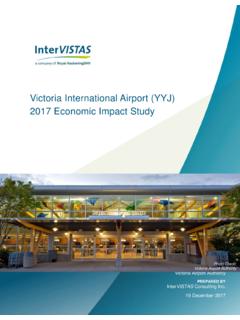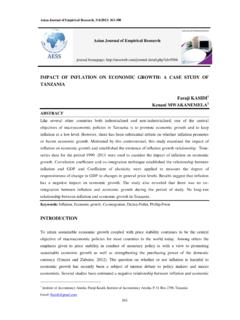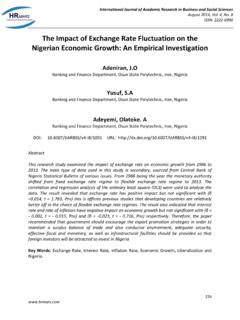Transcription of The Economic Impact of Expanding Natural Gas Use in ...
1 The Economic Impact of Expanding Natural Gas Use in connecticut Stanley McMillen, Managing Economist Department of Economic and Community Development Nandika Prakash Economist Department of Economic and Community Development December 2011 1 Executive Summary Southern connecticut Gas, connecticut Natural Gas and Yankee Gas commissioned the Department of Economic and Community Development (DECD) to perform an Economic analysis of a gas main expansion scenario leading to increased customer conversions from oil heat to Natural gas heat. The buildout and conversion period occurs between 2012 and 2021 during which there is significant construction and changeover from oil to Natural gas space and water heating equipment that drives new Economic activity. The expansion of connecticut s Natural gas infrastructure entails costs and benefits for home and business owners.
2 The costs include both the customer costs to convert hearing equipment and the utility s costs to expand mains and connect homes and businesses to the system including service and meter costs. The benefits include increased Economic activity due to increased construction activity, reduced customer bills due to the price differential between oil and gas. In addition, the analysis includes the loss of oil heating business as a cost and the reduction of CO2 emission and its related price as a benefit. The analysis does not count the reduction of other oil heat emissions such as SOx, NOx and mercury. For purposes of this analysis, we assume that utilities pay for the infrastructure buildout and home and business owners pay for equipment conversion. The largest increases in jobs, taxes and state gross domestic product occur from 2012 through 2021.
3 In that time period: o A total of 54,000 job-years of net total employment (8,000 jobs/year in the first five years and 3,100/year in years 6-10). o $ billion of increased net GDP over the expansion period ($ billion first five years and $ billion in the later years) and $ billion of increased state revenue (86% realized in the first five years). Once the expansion is completed in 2021, a set level of savings will accrue to customers and business owners: o $250 million/year injected into connecticut s economy (once program is in place) by saving residential customers up to $1,200 per year on their heating bills. 2 o $215 million/year reduction for commercial and industrial customers production costs once program is in place. From 2022 through 2050, the costs and benefits continue but at a lower level than during the first ten years.
4 Table ES-1 summarizes the results over the entire period of analysis as annual average changes with respect to the baseline or no build forecast of the connecticut economy. Given the costs of conversion and the benefits realized by homeowners, their investment breaks even in six years. Similarly, commercial establishments converting to Natural gas from oil realize an investment breakeven period of years, while industrial customers break even on their investment in less than half a year. As a result of these oil to gas conversions, connecticut will have cleaner air, a lower carbon footprint and its businesses and homeowners will have lower production costs on the one hand and increased household consumption on the other. If the United States can tap further into its Natural gas resources, conversion from oil to Natural gas may in addition reduce our imports of oil and improve the nation s trade balance.
5 Average Annual Change in Key Variables Above the Baseline: 2012-2050 Total EmploymentNon-Farm EmploymentConstruction JobsPopulationGDP (Millions 2010$)Output (Millions 2010$)Personal Income (Millions 2010$)Net State Revenue (Millions 2010$)All Counties702626620738$ $ $ $ $ $ $ $ $ $ $ $ $ $ $ $ $ $ $ $ Haven243217191290$ $ $ $ London21131333$ $ $ $ $ $ $ $ $ $ $ $ $ $ $ $ ConversionsOff-Main Extensions and ConversionsTable ES-1: Annual Average Changes in Key Economic Variables: 2012 through 2050 3 This analysis excludes the potential conversions from low-efficiency oil appliances to high-efficiency oil appliances because that analysis is beyond the scope of this work. Further, a new set of assumptions, costs and benefits needs to be determined for this type of conversion.
6 There is no doubt that Natural gas will not be available everywhere in connecticut in the foreseeable future and therefore that oil conversions will undoubtedly occur. Such analysis is future work. Overview This project models a potential Natural gas infrastructure build-out in connecticut . While much of central connecticut has gas service in the street (gas mains), there are potential gas customers in this region that have not connected with the mains in the street or converted their oil heating appliances to gas heating appliances. In addition, there are areas in Tolland, Windham and Litchfield counties for example where there are no mains. The Natural gas infrastructure build-out occurs over a 10-year period and proceeds along two paths: on-main conversions and off-main expansion.
7 On-main conversions occur from 2012 through 2021 and consist of connections of customers to existing nearby mains and conversion to gas appliances thus increasing the number of customers in connecticut s existing Natural gas service areas (see Figure 1). We present this analysis for each county. In addition and contemporaneously, off-main expansion occurs from 2012 through 2021. In the first five years (2012-2016), the gas companies extend mains into areas that offer the highest potential for conversion based on many factors including usage and density. Connections and conversions occur along the extended mains as service becomes available on a statewide basis from 2012 through 2021. For the purposes of the analysis, we assume that no further conversions occur after 2021 for customers on existing mains or along the new mains.
8 DECD did not consider the potential for converting electric space heating as part of the analysis. 4 As conversions occur through 2021, the benefits of using Natural gas accumulate annually as more customers switch from oil to Natural gas. After 2021, the benefits of conversion described below continue through 2050 (the Economic model s horizon) but do not accumulate because we assume that no new customers convert. Funding for the gas infrastructure build-out comes from several sources. As the gas companies customer base grows, there will be internal funding available from increased gas sales. In addition, the state will seek federal and private sector funding possibly including surcharges on gas ratepayers. As is generally the case today, the costs for connecting residences and businesses to mains would be primarily borne by the gas utilities and the costs of converting existing space and water heating equipment would be borne by home and business owners.
9 The benefits of converting from oil space and water heating equipment to gas space and water heating equipment are several. One benefit of conversion from oil to Natural gas is that for a given heating requirement, Natural gas is less expensive than oil per unit of fuel. Further, gas heating appliances are more efficient than oil heating appliances (that is, they convert more of the heat energy available per unit of fuel than oil appliances do and require less electricity to operate). Moreover, carbon emissions per unit of fuel is lower for Natural gas than for oil-fired equipment and there is no NOx, SOx or mercury emitted with Natural gas combustion. For the region, this implies that as conversion to Natural gas from oil proceeds there will be less carbon emissions in the aggregate.
10 Finally, the Natural gas infrastructure build-out increases municipalities grand lists by adding value to the properties it touches and by the taxes that gas utilities pay. As total energy costs decline because of conversion, households and businesses have more income to spend on other goods and services and the region becomes more competitive than it was with respect to other regions not making these investments. Figure 1: Coonnecticut s Naatural Gas Servvice Areas 5 6 Given the costs and the benefits mentioned, there is a net benefit after the investment in build-out, connection and conversion is amortized (see Tables 1, 2 and 3). However, other long-run costs must be considered. The residences and businesses that convert to gas will switch from their oil vendor to their Natural gas supplier.















